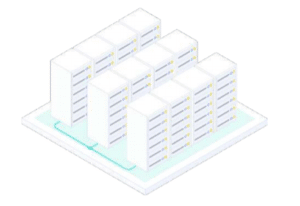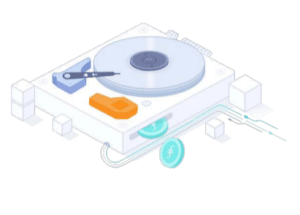- What is Filecoin?
- The Problem with File Storage & Data Usage
- Two Types of Nodes
- How Filecoin Works
- Unique Consensus Mechanism
- Protocol Labs
- Filecoin Token (FIL) ICO
- Token Allocation
- How to Buy Filecoin (FIL)
- Where to Store Filecoin (FIL)
- Filecoin Roadmap for 2018
- Conclusion
What is Filecoin?
Filecoin is an eagerly anticipated decentralized storage solution. In 2017, Filecoin’s initial coin offering became the largest token sale in history, collecting $257 million in contributions.
The project is still under development, and the developers have not yet released an alpha version. A few early storers and miners are currently testing the network, though. That said, there’s reason to be excited about Filecoin. The team is well-respected in the industry, and they’ve also produced successful projects in the past.
In addition to the record-breaking ICO, Filecoin also received investment from top venture capitalists in Silicon Valley, including Y Combinator, Naval Ravikant, Andreessen Horowitz, and Winklevoss Capital. This magnitude and mix of funding, combined with the team’s experience, give this project a level of legitimacy rarely seen in the crypto industry.
This article will explore whether the project warrants the hype it has received.
The Problem with File Storage & Data Usage
Current data storage solutions, like Amazon and Google, are centralized and therefore vulnerable to attack. We’ve seen this play out with high-profile data breaches. Perhaps the most notable recent breach is the Equifax hack.
Additionally, we’re creating massive amounts of new data every year. This year, humanity will produce more data than in the past 5,000 years combined. The demand for storage doesn’t seem to be slowing down.
Filecoin seeks to capitalize on the increasing demand for storage using blockchain technology to coordinate a peer-to-peer network of storage nodes. However, it’s not alone. The race to be the best decentralized storage solution is crowded. Platforms like Storj and Sia have already launched and are building a user base. Decentralized storage is gaining traction as a viable solution for more secure storage.
Where Filecoin fits into the decentralized storage ecosystem is user control. Storj and Sia control pricing for their platforms while Filecoin implements a marketplace for bidding between uploaders and hosts. This marketplace is incentivized to make storage much cheaper over time. Filecoin also gives users the ability to prioritize speed, redundancy, or cost when making their orders.
Two Types of Nodes
A major part of Filecoin’s value proposition is its unique architecture. Where most networks implement a single, standard type of node, Filecoin proposes a dual solution.
1. Storage Nodes

Ideally, Filecoin wants to incentivize mid-sized storage nodes. Huge data centers would be too centralized and defeat Filecoin’s mission. However, small operators would be equally problematic with inconsistent connections and little available space.
2. Retrieval Nodes
Retrieval nodes are unique to Filecoin’s system. They need to be located close to the storage nodes on the network. However, retrieval nodes also need high bandwidth and low latency. They get paid when they are the fastest to locate and retrieve a file for a user.
In practice, this likely means the most successful retrieval nodes will operate on fast connections in high-density population centers where many storage nodes operate simultaneously.
How Filecoin Works
As a Filecoin user, you’ll specify the file you want to upload and pay a small fee to have your upload request listed on the Filecoin exchange. There, storage nodes will bid on the rights to store your file. This bidding process is designed to get the uploader the lowest price possible. The Filecoin exchange is a decentralized exchange with its orderbook living entirely on the Filecoin blockchain.
After that, Filecoin encrypts your file and divides it into many segments. These various segments get sent to various points on the network that bid to host your file. The exact location of all your file segments gets recorded on the Filecoin blockchain in what’s known as an allocation table. In order to recall all the pieces of your file, you must know the file’s private key. Only the file owner has the private key, so only the file owner can find, reassemble, and decrypt the file.
Unique Consensus Mechanism
Filecoin’s developers created a unique consensus mechanism for Filecoin. Consensus mechanisms can be thought of as incentive schemes for securing the network. In Bitcoin’s proof of work consensus, the incentive is to provide lots of processing power for the hashing algorithm.
The novel solution of Filecoin is using consensus to incentivize hard drive space instead of computing power. The proof of replication consensus model requires miners prove to a verifier that they have created various copies of various files on the network. This increases redundancy and reliability of the network while also incentivizing storage nodes to add more disk space to the network.
The full version of the proof of replication consensus mechanism is not yet available to the public. Therefore, it’s difficult to nail down the specifics of how the protocol will work. However, the development team has released a white paper with preliminary explanations.
Protocol Labs
Much of the excitement behind Filecoin has to do with the team creating it. Protocol Labs is a well-respected team in peer-to-peer technology. They’re the company behind projects like IPFS, libp2p, IPLD, Multiformats, and CoinList. Filecoin leverages those other technologies, especially IPFS, which already has a lot of the peer-to-peer file transfer and storage infrastructure already in place.
Needless to say, the team is steeped in the blockchain tradition. They have extensive experience deploying open source technology. They’re also very familiar with the code bases of other projects in the space. They’ve specifically cited Ethereum and Zcash as influences on how they think about implementing Filecoin’s blockchain and smart contracts.
Prior to the Filecoin ICO, Protocol Labs operated with a relatively slim budget of $3.5 million, building these various, rather successful projects on a shoestring.
[thrive_leads id=’5219′]
Filecoin Token (FIL) ICO
The Filecoin ICO is the biggest token sale in history, bringing in a whopping $257 million. The pre-sale and ICO combined represent 10% of the overall token allocation.
The ICO was only open to accredited investors, as defined by U.S. regulations. In practice, this generally means individuals with over $200k in income or a network of over $1 million. Filecoin strove to meet regulatory compliance standards with their ICO. However, many community members felt snubbed by the decision to cut out small-time investors.
Investors could choose to vest their tokens for various time periods in order to earn a discount on the initial purchase. Filecoin sold the tokens as a SAFT (Simple Agreement for Future Tokens). No FIL tokens exist yet, and they will not exist until Filecoin launches its genesis block. Anyone claiming to own FIL or offering it for sale is lying.
Token Allocation
30% of the allocation will be created and disbursed at genesis: 15% to the development team, 10% to investors, and 5% to the Filecoin Foundation. That 15% team allocation, along with a further 5% to the Foundation is rather high. Especially so, when you consider the massive amount of funds raised.
The remaining 70% is reserved for mining rewards. Miners will earn the rewards with every block in exchange for replicating files on the network.
How to Buy Filecoin (FIL)
The ICO has ended, and FIL tokens don’t exist yet. As such, you can’t currently buy FIL.
Gate.io is selling Filecoin futures for those interested in speculating on the future price of FIL after launch.
Where to Store Filecoin (FIL)
FIL tokens don’t exist yet, so there’s nothing to store at this time. When it launches, FIL will come with their own native wallets.
Filecoin Roadmap for 2018
The developers released an extensive roadmap for 2017 ahead of the ICO. However, they have yet to release a similar roadmap for 2018.
We can safely assume the development team is hard at work creating and testing the Filecoin network with their early round of private users. We don’t yet have a release date for a public testnet or alpha version, much less a full version. Communication is one area where the Filecoin team has been weak in the aftermath of its ICO.
Another priority for Filecoin in 2018 is hiring. They’re looking to expand rapidly from a rather small team to a large effort worthy of a $275 million fundraising round.
Conclusion
Filecoin certainly has the team and the capital to make a big splash in decentralized storage. However, they’re entering a market that already has established competitors. Ultimately, the usability and robustness of its product will be the determining factor if Filecoin is to fly or flop.
Never Miss Another Opportunity! Get hand selected news & info from our Crypto Experts so you can make educated, informed decisions that directly affect your crypto profits. Subscribe to CoinCentral free newsletter now.













